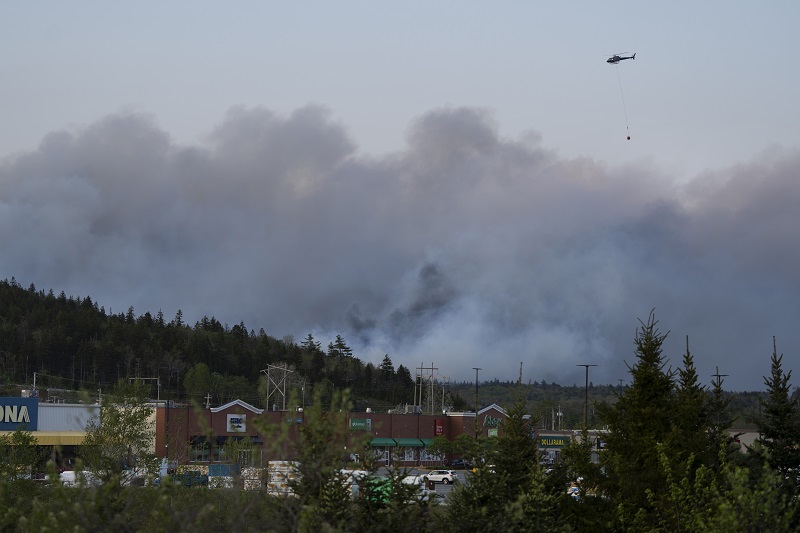Will this be the worst wildfire season Canada has ever seen?

OTTAWA – This is on track to be the worst fire season Canada has ever seen and the risk of wildfires will remain well above average in most of the country throughout the summer, the federal government warned Monday.
At the rate fires are spreading across the country, the total land area burned could surpass the all-time annual high by next week.
“The situation remains serious,” Emergency Preparedness Minister Bill Blair said as he and six other federal cabinet minister gave an update on the situation.
“The images that we have seen so far this season are some of the most severe we have we have ever witnessed in Canada and the current forecast for the next few months indicates the potential for continued higher-than-normal fire activity.”
As Blair spoke in downtown Ottawa, smoke from fires north and west of the city had settled over Parliament Hill, clouding the iconic Peace Tower in a grey haze.
On Friday afternoon there were 324 fires burning across Canada.
As of Monday morning that had grown to 413, and by late afternoon, the total jumped again to 424.
A structure destroyed by recent wildfires is shown in Drayton Valley, Alta. on Wednesday May 17, 2023. Air quality statements continue to blanket much of British Columbia and the Prairie provinces as scores of wildfires rage across the region. THE CANADIAN PRESS/Jason Franson
More than 250 fires were burning out of control, stretched across nine provinces and two territories.
As of June 5, more than 2,200 fires had been recorded this year.
They have so far burned 36,000 square kilometres of land – an area more than five times the size of Banff National Park, and more than the annual totals for all but four previous years.
The most land ever burned in a single year was 46,000 square kilometres in 2014.
Over the weekend, an average of about 1,800 square kilometres burned each day. If that pace keeps up, the 2023 total will surpass 2014 within the next week.
A new fire risk forecast shows that risk remains well above average in parts of every province and territory except Newfoundland and Labrador.
The risk in most of Labrador is still above average, while the risk in Newfoundland is just average.
There is very little change to the forecast for Western Canada for July or August, but the risk is expected to drop substantially in the Maritimes and eastern Quebec. In most of Ontario and western Quebec, the risk is slated to go from “well above average” to “above average.”
Natural Resources Minister Jonathan Wilkinson called the new forecast sobering.
“It shows us that this year’s already devastating season could well get worse,” he said.
High alert
“Every province and territory will need to be on high alert throughout this wildfire season.”
There are now nearly 1,000 firefighters helping battle the flames from the United States, Australia, New Zealand and South Africa. Additional firefighters from France are also expected, Blair said.
The season’s severity is unusual not just in how many large fires are burning, but also because they are burning in almost every province at the same time.
Mike Norton, the director general of the Northern Forestry Centre at Natural Resources Canada, said having coast-to-coast fires in the spring is not normal.
Most years, the Canada Interagency Forest Fire Centre co-ordinates the sharing of equipment and firefighters not just internationally, but also between provinces. That is proving a challenge this year.
Norton said with the international help there should be enough crews.
The military has been called in to help, with 150 soldiers in both Alberta and Quebec and 200 in Nova Scotia.
NDP MP Richard Cannings, the party’s emergency preparedness critic, said even though the government is working as fast as it can it still took several days to train soldiers in the firefighting skills they needed, and to get the equipment Nova Scotia needed in place.
“Because of how we organize this in Canada, we weren’t ready,” he said.
Cannings said the federal government needs to be able to respond at a moment’s notice.
Conservative Leader Pierre Poilievre said his party is “open to studying any solutions that will help the country better co-ordinate its waterbombers and other assets so that those assets are where they are needed, when they are needed, as quickly as possible.”
Prime Minister Justin Trudeau said the government is focused on getting through this fire season.
“We’re going to get through this together and our government will keep being there with whatever it takes to keep people safe and provide support,” he said.
He acknowledged, though, that with climate change heightening the fire risk, there are lessons to be learned and decisions to be made about making Canada better able to respond.
“This is a scary time for a lot of people, not just in Alberta, but right across the country, including in the Atlantic, the North and Quebec, too.”
Feature image: A helicopter carrying water flies over heavy smoke from an out-of-control fire in a suburban community outside of Halifax that spread quickly, engulfing multiple homes and forcing the evacuation of local residents on Sunday May 28, 2023.THE CANADIAN PRESS/Darren Calabrese







